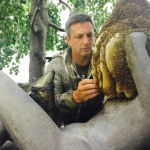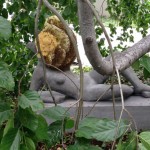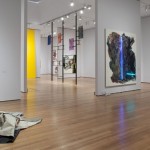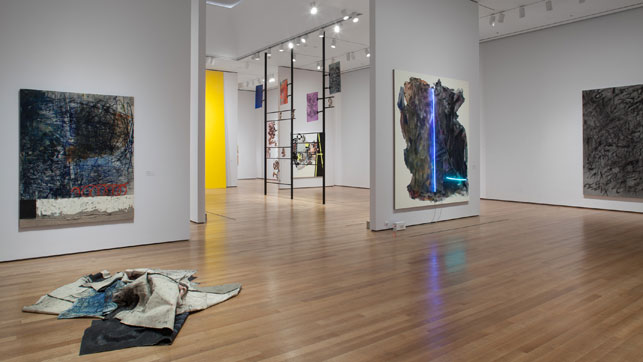To celebrate the installation of Pierre Huyghe’s Untilled (Liegender Frauenakt) [Reclining female nude] in The Abby Aldrich Rockefeller Sculpture Garden, MoMA’s curatorial and digital media teams have collaborated on a bee-cam, presented here for the first time, in order to give online viewers the chance to follow the activities of our honeybee colony during one day of the exhibition.
For this special summer presentation of Untilled, MoMA has partnered with urban beekeeper Andrew Coté, who maintains apiaries all over New York City, is founder of the New York City Beekeepers Association, and sells his rooftop and varietal honeys at the Union Square Greenmarket on Wednesdays and Saturdays. I recently spoke with Andrew about his involvement with the installation as well as the wider field of local beekeeping. Read our discussion below:
Margaret: We understand you come from a long line of beekeepers. How did you get involved in beekeeping in New York City?
Andrew: Beekeeping has been in my family since at least the 1800s, in a French speaking area of northern Canada. My great-grandfather, grandmother, and father were (and in the case of my father, is still) beekeepers. When I moved to New York City I did not see why I should leave beekeeping, which through my father I have been involved with for over three decades, behind. In fact, New York City has had honeybees as part of the landscape since shortly after the Lenape Native Americans greeted Henry Hudson. The Dutch kept bees down in what is now Battery Park and also on Governor’s Island in the 1600s. Later, honeybees pollinated the orchards of what is now the Lower East Side. A hundred years ago in NYC, beehives were commonly found atop orphanages and hospitals as a means of generating sweets for the kitchens. There are many examples and the honeybee has been pollinating the Big Apple since before the Dutch traded it for some rubber trees in Surinam.We were surprised to learn that there is a very active beekeeping community in New York City including not only individuals but also businesses. Who keeps bees here and why?
The New York City Beekeepers Association is an urban hive for all of Gotham City, with hundreds of members. The stereotypical idea of the beekeeper is the retired firefighter or machinist, and almost always a man. But in New York City, there are beekeepers that span the spectrum, from medical doctors and university professors to hipsters to school bus drivers to the unemployed to hairdressers to NYPD Detectives and Bomb Squad officers. Men, women, and children keep honeybees in New York City. NYC beekeepers are such an eclectic group as to defy the usual idea of who is a beekeeper—but countrywide, most beekeepers are men over 50 years old.Here in New York City, companies like the Waldorf-Astoria, Brooks Brothers, Green Naftali Gallery, The Rudolf Steiner School, and several other groups and businesses including restaurants, bakeries, and community gardens house honeybee hives. The New York City Beekeepers Association estimates that about 500 beehives are active in the five boroughs, though only about half that number are registered.
Where are some other beehives in Manhattan located?
There are beehives at a community garden at Rockaway Beach, in the oldest Catholic cemetery (dating from the 1770s) on Mulberry Street at St. Patrick’s Old Cathedral, atop St. Mary’s on Grand Street, atop a ballet school on 19th Street, on the roof of a tenement in Harlem; crowning synagogues and on private balconies. A French bakery in Bushwick. There are even two beehives sitting quietly gathering nectar and pollen nearby as understudies in case the bees on Untilled grow tired of their position and decide to explore other options.
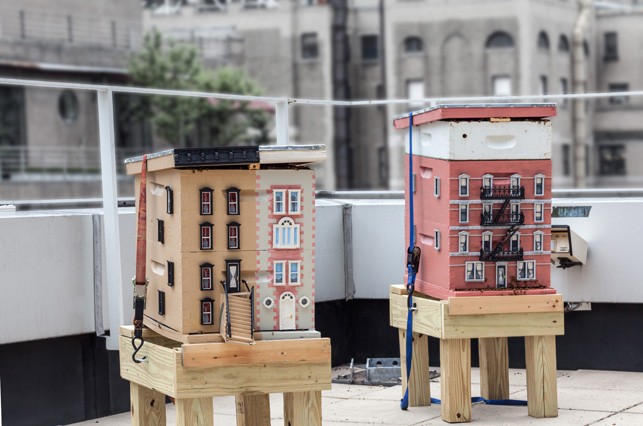
Two beehives, modeled like city buildings, are kept on a nearby rooftop in case additional honeybees are required during the exhibition of Untilled. Beehives by Sasha Pinto. Photo: John Wronn. © 2015 The Museum of Modern Art
What are some of the challenges of urban beekeeping?
Seriously speaking, one of the biggest challenges of urban beekeeping is dealing with traffic and parking. For the beekeeper who maintains more than one apiary and who needs to haul equipment, these two factors are the most difficult and time consuming. Also difficult is finding a suitable location to place bees. Getting permission from a landlord to place boxes of hundreds of thousands of flying stinging venomous insects on a rooftop is not an easy sell. Not falling off of the roof is also important, especially when, for instance, a bee flies into the nose of the beekeeper, making it difficult to maintain composure and balance (this may be phrased in a mocking tone, but, the problem is real). Then there is carrying the sometimes-very-heavy equipment up and down elevator-free buildings, ladders, and through hatch doors. It is hot, sticky, messy, often painful work, but with sweet rewards.What does NYC honey taste like?
The spring and fall honeys from New York City are distinctly different, with the spring more of a light honey with a minty citrus taste, and the fall honey much darker, rounder, and richer—sometimes with a hint of spice. Honey comes in a range of colors depending on the plant nectar source, and those different plant sources also gives the honey different flavors.What are some of the challenges of presenting bees in a public space? What special considerations were there for the installation of Untilled in the Museum’s Sculpture Garden?
Whenever placing a beehive anywhere it is very important not only to consider the true needs of the honeybees but also the perception of those honeybees for the humans who may come into contact with them (or may just be aware of them). People are often not well informed about honeybees and allow their prejudices and fears to guide their feelings about them. Education about honeybees and their beneficial and docile nature wins over most worried civilians in regards to honeybees. The rest can stay away from the hive.In regards to special considerations when installing Untilled in the Sculpture Garden, we wanted to establish a natural barrier that would prevent people from coming too close to the hive for the safety and protection of both the bees and the public, yet not interrupt the viewing pleasure for John Q. Public. I believe that was well handled. Bees need a bit of space to take off and land, and that space needs to be free of curious art lovers. As curious as people are about art and bees (and bees as art), most possess a level of self preservation that forbids them from getting too close or curious about the installation. Through the natural barriers that exist with the meeting of the stone patio and the greenery, and the constantly present vigilant security team member, we are happy to report that things have been going smoothly.
Is this the first time you’ve worked with bees in the context of an art installation?
I have worked with honeybees in a great many ways—placing beards of bees on people’s faces, putting bees on the feet of a mannequin in front of a green screen for a television commercial for an athlete’s foot cream, traditional observation hives for educational purposes. I have wrangled bees for the cover of Time magazine, but this is the first time I have installed honeybees as part of an art installation. When Pierre Huyghe’s studio contacted me in 2011 to discuss how this could be done, I thought it was an interesting project, and I am so pleased to be part of it coming to fruition here at MoMA. I traveled with two of my team members to Los Angeles to see the installation there, and learned from the successes and difficulties their beekeeper faced. I also communicated with the beekeeper in Germany and of course, Huyghe’s team. It has been and continues to be a fascinating project.
![Beekeeper Andrew Cote during the sculpture's installation. Shown: Pierre Huyghe. Untilled (Liegender Frauenakt) [Reclining female nude]. 2012. Concrete with beehive structure, wax, and live bee colony. The Museum of Modern Art, New York. Purchase. © 2015 Pierre Huyghe. Photo: TK](https://www.moma.org/wp/inside_out/wp-content/uploads/2015/07/Andrew-Cote-photo-643x482.jpg)
Beekeeper Andrew Coté checks on the hive daily. Shown: Pierre Huyghe. Untilled (Liegender Frauenakt) [Reclining female nude]. 2012. Concrete with beehive structure, wax, and live bee colony. The Museum of Modern Art, New York. Purchase. © 2015 Pierre Huyghe. Photo: New York City Beekeepers Association
How are the bees doing in their Sculpture Garden environment? Do they stay in the garden all day?
The bees are doing very well and are seemingly quite pleased to be a part of the art community. Few beehives can boast to being in such good company—works by Henri Matisse, Henry Moore, Pablo Picasso, and other great artists are the immediate neighbors to these tens of thousands of honeybees. They are enchanted by live classical music or jazz on Sunday evenings. They are the best looked after beehive in the world, perhaps, getting two inspections from a professional beekeeper each and every day for a total of 14 inspections per week or 56 inspections per month—not to mention that they are probably the most photographed colony of bees in the history of the world, with hundreds if not thousands of people from all over the world photographing them seven days a week. Yoko Ono has even stopped by to greet them. They are happy bees indeed.Despite this luxurious setting and the constant attention, the forager bees do just as their name implies—they forage for nectar, pollen, and water, and do so up to three miles from their home. Most, according to the orientation of their flight paths, are headed to Central Park to enjoy the nearly 1,000 acres of bounty there. Many others make beelines for Park Avenue where, as the name implies, they feast on the smorgasbord of nectar on offer there. Their honey may be the most complex, cosmopolitan honey ever concocted by the alchemy through which bees spin nectar into liquid gold.
What is the lifespan of the colony?
It depends how you choose to look at it. The lifespan of the average honeybee is six to eight weeks. The average queen lives for three years. A colony of honeybees will expand and contract from 10,000 to 75,000 bees at different points in the year. However, since a colony can regenerate a new queen, that colony may live on indefinitely, if it is healthy enough to do so and all conditions are correct.What do you think people should know about bees and what are the most common misconceptions?
People should know that even if this beehive was not gracing the Sculpture Garden, there are currently 258 types of apis (bees) flying around New York City right now (and that does not include the vespa (wasps). So, they live among us now, have been here longer than we have, and without them we would have significantly less pollination. Speaking of honeybees (Apis mellifera), they are docile, not at all interested in stinging or harming anyone (if a bee approaches you, just calmly walk away, without flailing your arms or screaming), and are only interested in the pursuit of nectar, pollen, and water. Knowing that without the labor of the honeybee we would be in dire straights with our food supply is one way that we can appreciate these misunderstood yet sorely needed creatures.We’ve all read about colony collapse and the challenges facing the bee population. What can we do to support bees?
Buying honey from a local beekeeper is a good start, and not honey that was trucked and shipped tens of thousands of miles to make it to the store shelf. Supporting farmers’ markets like Greenmarket is a nice way to lower one’s carbon footprint and support local agriculture such as beekeeping, which supports the bee population. Not using chemicals on our properties would go a long way to helping the bee population.


